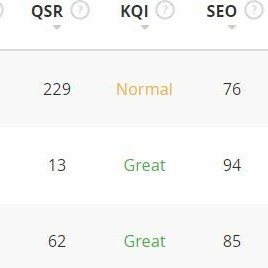Let’s first start off by talking about the competitive analysis in the SEO world. This is about understanding how your rivals are getting traffic from search engines, and how you can learn from their successes (or failures) to boost your own SEO game.
You’re going to find out about the ways in which digging into your competitors’ keywords can uncover golden opportunities for your website.
Now, the backbone of any solid SEO strategy is thorough keyword research. It’s not just about picking the right words; it’s also about understanding the intent behind them and how they fit into your audience’s journey. When you couple traditional keyword research with competitive analysis, you get a more rounded view of the SEO landscape, which can inform and enhance your strategy.
Of course, this isn’t just a matter of peering over the virtual fence at what your neighbors are doing. It’s about doing so with an approach that puts people first, aligning with the principles of Experience, Expertise, Authoritativeness, and Trust.
When you focus on providing the greatest value to your users with content that speaks to their needs and interests, you’ll naturally improve your site’s visibility and search rankings.
So, with the stage set for a deep dive into the competitive waters, you might be wondering: How do I spot my actual SEO competitors?
That’s what the next section is all about. You’re about to learn the savvy methods for identifying who’s contending for your audience’s attention and how to use that knowledge to carve out your own spot in the SEO landscape.
Identifying Your True Competitors
You might think you know who you’re up against in the digital space, but when it comes to SEO, the landscape can be quite different. Your SEO competitors are those who rank for keywords that are crucial to your business, regardless of whether they offer similar products or services.
Identifying these competitors is the first step to a focused competitive analysis. Tools like SEMrush, Ahrefs, and Google’s own Search Console can help you spotlight who’s appearing in search results for the keywords you’re eyeing.

It’s not just about who’s at the top, but also about who is consistently performing well for a variety of terms within your niche.
Analyzing these competitors’ domains can unlock a treasure trove of keyword opportunities. Look for overlapping keywords that multiple competitors rank for, as these are likely to be highly valuable.
Conversely, sniff out the unique keywords each competitor ranks for to identify potential gaps to exploit. Remember, the goal is to find a sweet spot of relevance and opportunity in the keywords you choose to pursue.
Understanding your market niche is crucial in this process. The more specialized your niche, the more precise your competitive analysis needs to be.
While wide-reaching keywords might draw traffic, niche-specific keywords can attract the right kind of traffic — leading to better conversion rates and a stronger online presence.
Analyzing Competitor Keyword Performance
I’m going to guide you through assessing your competitors’ keyword rankings and search volumes. This is crucial because not all keywords are worth pursuing – some are too competitive, while others may not draw enough traffic to make a dent. We’ll pinpoint the high-value keywords that you might be overlooking.
Once we’ve got a list of what’s performing well for others, you’re going to find out about identifying content gaps. These are the golden opportunities where your competitors haven’t fully capitalized. By leveraging these gaps, your content can shine in areas others have neglected.
You’re not just looking for random keywords; you want to use competitors’ positioning to inform a strategic approach.

Think about what their rankings say about their content quality, relevance, and authority. This isn’t just about mimicking them, it’s also about outperforming them.
Moreover, because the digital landscape is so dynamic, it’s essential to keep a pulse on the evolving trends.
What works today might not work tomorrow, so your keyword strategy has to be fluid. You’ll see how flexibility in response to new data and trends can not only keep you competitive but also ahead of the curve.
Now, moving into crafting your strategy, you’ll use these insights to select and prioritize keywords for your own content.
The focus should be on those with enough search volume to drive traffic, but not so competitive that ranking is unlikely. It’s a fine balance that, when struck correctly, can yield substantial SEO dividends.
Crafting a Strategy Based on Competitive Insights
If you want to advance in the SEO game, it’s crucial to transform your competitive analysis into a coherent strategy. That means selecting keywords that are not only relevant to your brand but also gauge the real intent behind the searches.
It’s all about balance. You’re going to discover how to juggle short-tail and long-tail keyword opportunities to hit the sweet spot between traffic volume and conversion potential.
Sorting your keywords is key. Choose something that resonates with your audience while ensuring you’re not just a small fish in a big pond.
Leverage the competitive insights to identify gaps that you can fill, and occasionally, dare to tackle some of the more competitive keywords if you believe your content can be authoritative and exceptional.
Creating content should always start with audience intent in mind. What are they really looking for? Sometimes it’s not the most obvious keywords that convert but rather the ones that address specific problems or questions.

This content must be distinctive and stick out—for a good reason. Providing utility, offering a fresh perspective, or presenting complex information in a digestible manner can be your competitive edge.
Remember, the execution of your strategy isn’t set in stone. Continuous improvement and adaptability should be at the heart of your strategy, ensuring that it evolves with search trends and audience needs.
Monitoring and Continuously Improving Your Keyword Strategy
I’m here to help you with the final piece of the competitive analysis puzzle. It’s crucial not to just set your keyword strategy and forget it. The digital landscape is ever-changing, and your approach should be, too.
Establishing robust tracking mechanisms is key. You’re going to want to set up tools that provide insights into your keyword rankings and measure the impact of your SEO efforts regularly.
Adapting is the name of the game. The insights gained from continuous monitoring allow you to refine your keyword list, add new targets based on trends, and retire those that no longer serve your goals.

Remember, the objective is to maintain a balance between a people-first approach and SEO efficiency. Your content isn’t just about keywords; it’s also about truly engaging and helping your audience.
Lastly, don’t be disheartened if things don’t go as planned on your first attempt. SEO is a long-term game. You can always adjust your approach down the road based on the data and feedback you collect.
Keep your content relevant, authoritative, trustworthy, and expertly crafted, and you’ll be well on your way to SEO success!



Hi Randi, Thank you for those important reminders about checking keyword opportunities. I am guilty of not checking my keywords at all and not using some sort of strategy. I just started using Semrush and Google Search Console. I do plan on doing competitor keyword analysis as you suggested moving forward,
Thank you, Athina, for your response! I’m glad you found this article useful and applicable to your site as well!